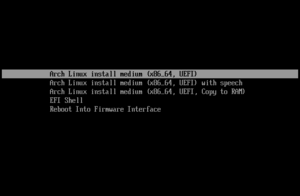Software:gummiboot
 | |
| Developer(s) | Kay Sievers, Harald Hoyer, Karel Zak |
|---|---|
| Final release | 48
/ January 30, 2015[1] |
| Written in | C |
| Type | UEFI boot loader |
| License | LGPL-2.1-or-later |
| Website | www |
systemd-boot is an open-source boot manager.[2] Its final independent release is version 48. It has since been merged into systemd as its systemd-boot component and maintained as such.[3][4][5]
Designed for systems using the Unified Extensible Firmware Interface (UEFI) and developed by the Red Hat employees Kay Sievers and Harald Hoyer, gummiboot is intended to be a minimal alternative to GNU GRUB that "just works": it automatically detects bootable images (including Linux kernel images, operating systems, and other boot loaders), does not require a configuration file, provides a basic menu-based interface, and can also integrate with systemd to provide performance data.
As a word play, the name "gummiboot" means "inflatable boat" in German, the native language of its initial developers.[6] Despite being developed by two of its employees, Red Hat's Fedora Project does not use gummiboot for booting UEFI systems; instead, it will use efilinux to chainload GRUB.[6][7]
gummiboot is licensed under LGPL-2.1-or-later, unlike GRUB which is licensed under the GPL-3.0-or-later. This distinction is intended to allow gummiboot to be suitable for use on UEFI systems implementing "secure boot",[6] due to concerns surrounding its requirement to distribute all authorization keys (digital certificates) needed to run GPL-v3-licensed software if hardware restrictions such as secure boot are in effect.[7]
See also
References
- ↑ "gummiboot - Simple EFI boot loader". freedesktop.org. http://cgit.freedesktop.org/gummiboot/commit/?id=2540801adc69277dca9ac19fb9443e368ffbfc31.
- ↑ Rod Smith (2013-04-27). "Managing EFI Boot Loaders for Linux: Using gummiboot". http://www.rodsbooks.com/efi-bootloaders/gummiboot.html.
- ↑ Michael Larabel (2015-05-21). "Systemd 220 Has Finally Been Released". Phoronix. https://www.phoronix.com/scan.php?page=news_item&px=Systemd-220. Retrieved 2015-08-17.
- ↑ Lennart Poettering (2015-05-21). "[systemd-devel] [ANNOUNCE] systemd v220". http://lists.freedesktop.org/archives/systemd-devel/2015-May/032147.html. Retrieved 2015-08-17.
- ↑ Michael Larabel (2015-07-07). "Gummiboot is Dead". Phoronix. https://phoronix.com/scan.php?page=news_item&px=Gummiboot-Is-Dead. Retrieved 2015-08-17.
- ↑ 6.0 6.1 6.2 "Gummiboot is an EFI boot loader that "just works"". The H. http://www.h-online.com/open/news/item/Gummiboot-is-an-EFI-boot-loader-that-just-works-1628719.html. Retrieved 11 September 2012.
- ↑ 7.0 7.1 "Ubuntu details its UEFI secure boot plans". Linux Weekly News. https://lwn.net/Articles/503803/. Retrieved 11 September 2012.
External links
- systemd-boot(7) - Manual page
- source code in systemd

